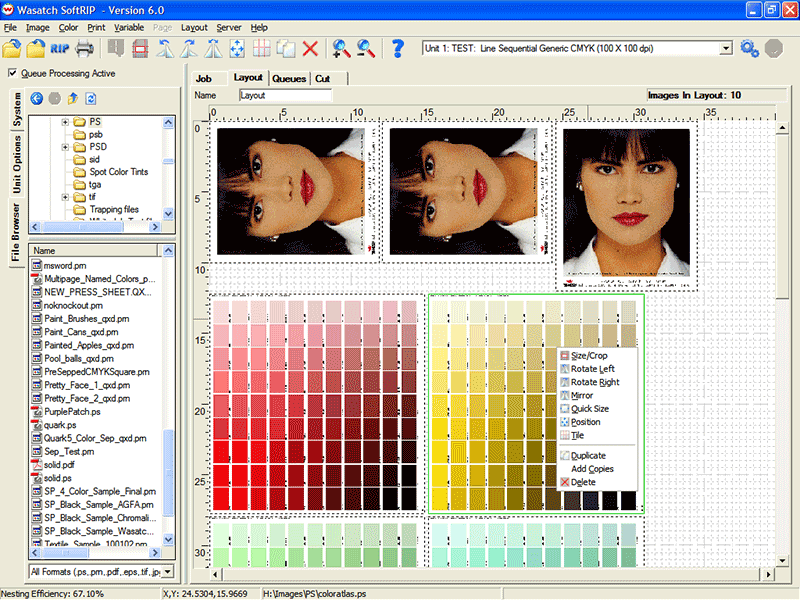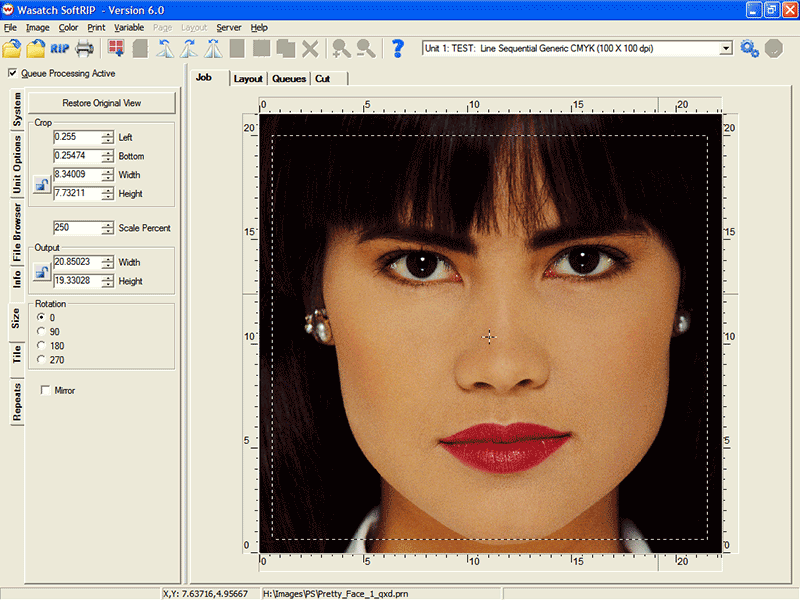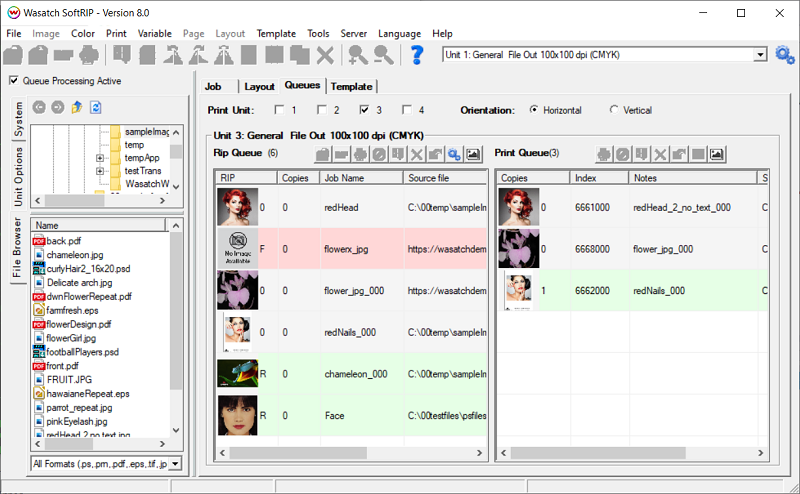
Illustration 1: SoftRIP Main Screen with Layout View
Below is a brief overview of Wasatch SoftRIP's main screen. The menus, tabs, and controls are covered in more detail throughout online help.

Illustration 1: SoftRIP Main Screen with Layout View
Use the File menu for opening files saved on disk or network. Files opened here are automatically displayed as screen previews when the Job tab is active, or imported to the current layout when the Layout tab is active. This menu also provides access to the Print Archive tool, and the Preferences window for changing optional settings.
The Image menu contains tools for modifying the image currently open in the Job tab, or currently selected in the Layout tab.
The Color menu contains key SoftRIP color tools for managing spot colors, color gamut, correction curves etc.
Use the Print menu to access printer and Imaging Configuration set up, and launch RIP/Print processing.
When active, this setting enables switching among different pages of a multi-page PostScript file.
The Layout menu accesses automated Smart Nesting tools, and other features to speed the process of creating efficient layouts.
Use the Server menu to configure Hot Folders and Wasatch ImageNET.
When enabled, the Language menu selects among non-English languages.
Use the Help menu to access online Help, program info, Service Data Uploader and online product registration.
Selects the printer to use for current job or layout processes. SoftRIP drives up to four printers.
Under normal conditions, this box is checked. When unchecked it flashes red. All processing stops when Queue Processing Active is unchecked. Uncheck the box to stop all printing in order to change system configurations or re-prioritize jobs.
Buttons on the tool bar are active or grayed-out depending on various selections of the tabs found below them on the main window. All tool bar operations can also be accessed from menu selections within the program, and all are documented with tool tips.
The tabs along the left and upper edges of the main window include many of the key file preparation and workflow tools in SoftRIP. Based on your top tab selections, tabs along the left of the screen may appear, disappear, or modify.
When the Job tab is selected (Illustration 2) you can open an individual input file, or job, to be prepared for printing. With the Job tab selected, a full set of options for sizing, cropping, scaling, and tiling appear.
When the Layout tab is selected, as shown in Illustration 1, you use the full width of your media as a digital canvas upon which you can prepare images to print as part of your complete production run. With this workflow, you can easily drag and drop images into the layout, manipulate them, and nest them to fit efficiently as part of your overall print run. The entire Layout can then be submitted to RIP and print.

Illustration 2: SoftRIP Main Screen Job View
When the Queues tab is selected (Illustration 3) the view becomes the master production control station of the RIP. On the Queues tab, all RIP and Print queues are displayed with the status of each job updated in real time. The display of thumbnails and colors can be changed in the Preferences tab.

Illustration 3: SoftRIP Main Screen Queues View
If the Wasatch Contour Cutting Option is activated, this tab appears for the scheduling of the cutting stages of "print and cut" jobs. Read more about cutting workflows in the Cutting section of online help.
Displays the status of all printers and job queues.
Includes settings for immediate or delayed nesting printing, annotations, crop marks, and registration marks.
Lets you quickly drag and drop files into the Job, Layout, or Queues windows.
Displays information about an open job, including real-time values for input and output color at any point on the previewed image.
Controls sizing, cropping, rotation, and mirroring for the current image on the Job tab.
Provides controls for "paneling" or "tiling" print jobs that are too wide for the current printer.
This tab appears if SoftRIP TX has been purchased, and allows for the interactive control of seamless repeats for textile printing. It is discussed at more length in the Textile area of online help.